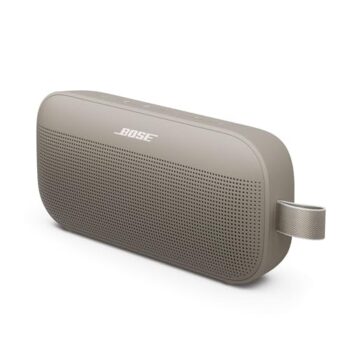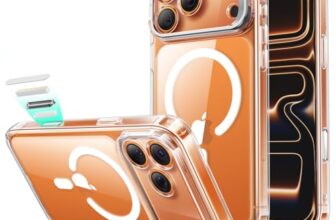A Feat of Engineering: A Technical Benchmark of the Bose SoundLink Flex (2nd Gen)
The field of portable audio operates under a constant and unforgiving set of physical constraints. The fundamental challenge for any acoustic engineer is to reproduce a full spectrum of sound—from deep, resonant bass to crisp, clear highs—within a compact and transportable enclosure. This is a battle against physics itself. Historically, achieving powerful, high-fidelity audio required large drivers, significant cabinet volume, and substantial power. The modern portable Bluetooth speaker, therefore, represents a convergence of cutting-edge materials science, sophisticated acoustic design, and, most importantly, intelligent digital signal processing. It is within this highly competitive arena that Bose, a brand synonymous with audio innovation, has introduced its latest contender: the Bose SoundLink Flex Portable Bluetooth Speaker (2nd Gen).
This is not merely an incremental update to a popular product line. The SoundLink Flex (2nd Gen) is a meticulously engineered audio delivery system designed to defy its compact dimensions. It is a showcase of Bose’s mastery over the interplay between physical hardware and the powerful software that governs it. From its custom-designed transducer and dual-opposing passive radiators to its intelligent PositionIQ technology that dynamically adapts the audio output to its orientation, every element of the Flex has been optimized for a single purpose: to deliver the best possible sound in any environment.
This review will adopt a deeply technical approach, moving beyond subjective descriptions to analyze the core engineering principles that define the SoundLink Flex. We will deconstruct its acoustic architecture, explain the science behind its adaptive audio technology, benchmark its durability based on its IP67 rating, and explore the technical advantages of its advanced Bluetooth 5.3 connectivity suite. This is a forensic examination of the hardware, software, and materials that combine to create what may be the top-performing portable speaker in the 2025 market. We will determine if the engineering reality lives up to the legendary Bose reputation.

Chapter 1: The Acoustic Architecture – Engineering High-Fidelity Audio
The soul of any speaker is its ability to reproduce sound accurately and powerfully. The SoundLink Flex’s surprisingly robust audio performance is not accidental; it is the result of a carefully designed acoustic system where each component works in concert to maximize output and clarity from a sealed, compact enclosure.
The Core Component: The Custom-Engineered Transducer
At the heart of the Flex is a single, custom-designed full-range transducer. In technical terms, a transducer is a device that converts one form of energy into another—in this case, electrical signals from your phone into the mechanical energy of sound waves. The design of this transducer is critical. Bose has engineered it for maximum “excursion,” which refers to the distance the speaker cone can travel back and forth. A greater excursion allows the speaker to move more air, which is essential for generating volume and producing lower-frequency sounds without distortion. The cone material is likely a proprietary composite, selected for its optimal balance of rigidity and low mass. It must be stiff enough to vibrate as a single piston without flexing (which causes distortion) but light enough to respond instantaneously to the rapid changes in the audio signal, ensuring crisp, detailed reproduction of treble and midrange frequencies.
The Science of Bass: Dual-Opposing Passive Radiators
The single greatest challenge for a small, sealed speaker is reproducing bass. Low-frequency sound waves are long and require a large volume of air to be moved. A small transducer simply cannot do this on its own without requiring immense power and excursion that would compromise the rest of the sound spectrum. Bose’s solution is the elegant implementation of dual-opposing passive radiators.
A passive radiator is not a powered speaker. It is a carefully weighted and tuned diaphragm that is moved by the changes in air pressure *inside* the speaker enclosure, which are created by the movement of the main active transducer. As the main transducer pushes outward, the internal air pressure increases, pushing the passive radiators outward. As it moves inward, the pressure decreases, pulling the radiators inward. In essence, they harness the otherwise wasted acoustic energy within the cabinet to produce deep, resonant bass frequencies that the main driver could never achieve alone. The “dual-opposing” configuration is a masterful piece of engineering. By placing one radiator on the front and one on the back and having them move in opposite directions, the reactive forces and vibrations they create are effectively canceled out. This ensures that the speaker’s energy is channeled into producing sound, not into vibrating its own cabinet. The practical result is that the SoundLink Flex can be pushed to high volumes without the entire unit shaking, rattling, or “walking” across a surface.

The Digital Brain: Bose’s Proprietary Digital Signal Processing (DSP)
If the transducer and radiators are the muscle of the SoundLink Flex, the Digital Signal Processing (DSP) is its brain. The DSP is a specialized microprocessor that analyzes and manipulates the audio signal in real-time before it ever reaches the transducer. Bose’s proprietary DSP algorithms are the secret sauce behind their signature sound. The DSP performs several critical functions:
- Dynamic Equalization (EQ): The human ear perceives frequencies differently at various volume levels. At low volumes, bass frequencies tend to disappear. The Bose DSP actively adjusts the EQ as you change the volume, boosting the bass and treble at lower levels to maintain a rich, balanced sound profile that doesn’t sound thin or tinny.
- Distortion Limiting: The DSP constantly monitors the audio signal for peaks that could potentially overdrive the transducer and cause distortion or “clipping.” It intelligently compresses these peaks in a way that is virtually imperceptible to the listener, allowing the speaker to play at its maximum possible volume without sacrificing clarity.
- Component Protection: The DSP also acts as a failsafe, ensuring that the electrical signals sent to the transducer are within its safe operating limits, preventing damage from extreme audio signals and contributing to the speaker’s long-term reliability.
This active, intelligent management of the audio signal is what allows the meticulously designed hardware to perform at its absolute peak, delivering a sound that is consistently clear, balanced, and powerful regardless of volume or genre.
Chapter 2: Adaptive Audio – A Technical Look at PositionIQ Technology
One of the most innovative features of the SoundLink Flex is its ability to sound great no matter how it’s placed. This is achieved through PositionIQ, an intelligent system that automatically optimizes the speaker’s audio output based on its physical orientation. This is not a gimmick; it is a practical application of sensor technology and dynamic signal processing to solve a real-world acoustic problem.

The Acoustic Challenge of Orientation
The way sound radiates from a speaker is heavily influenced by its position and the surfaces around it. A speaker standing upright will project sound differently than one lying flat on its back or hanging from a loop. In a conventional speaker, this would result in a compromised audio experience in certain positions—for example, highs might become muffled when lying flat, or bass might lose its punch when hanging in open air. PositionIQ is designed to counteract these effects automatically.
The Mechanism: Onboard Sensors and Dynamic DSP
PositionIQ relies on a built-in orientation sensor, most likely a multi-axis accelerometer, to detect its physical position in three-dimensional space. This sensor continuously feeds data to the DSP. The DSP is programmed with a set of unique equalization (EQ) profiles, each one acoustically optimized for a specific orientation. When the sensor reports a change in position, the DSP seamlessly crossfades to the corresponding EQ profile. This real-time adjustment ensures the speaker is always delivering the best possible sound for its current placement:
- Standing Upright: When the Flex is standing on its edge, the DSP applies an EQ profile designed for direct, focused listening. It optimizes the soundstage for a crisp, clear presentation, perfect for when the speaker is placed on a desk or shelf facing the listener.
- Lying Flat on its Back: When placed flat on a table, the DSP switches to a profile that creates a wider, more 360-degree soundscape. It adjusts the frequencies to radiate sound upwards and outwards, making it ideal for placing in the center of a group of people, so everyone gets a consistent listening experience.
- Hanging from the Loop: When hung from its utility loop (from a backpack or a tree branch), the DSP applies a profile that likely boosts certain midrange and bass frequencies to compensate for the lack of a reinforcing surface beneath it, ensuring the sound remains full and robust.
This intelligent, adaptive technology means the user never has to think about how to place their speaker to get the best sound. The engineering does the work for them, a hallmark of a well-designed, user-centric product.
Chapter 3: Engineering for the Elements – Durability and Portability
A portable speaker, by its very nature, is destined for a life of adventure. It will be tossed in bags, used by the pool, and set down on sandy beaches. The SoundLink Flex has been engineered from the ground up, using advanced materials and robust sealing, to not only survive but thrive in these environments.

Deconstructing the IP67 Rating: A Seal Against Nature
The Flex boasts an IP67 rating, which is an international standard for ingress protection. This code provides a precise measure of the device’s resilience against solids and liquids.
- The “6” – Solids Protection: The first digit refers to protection against solid foreign objects. A rating of 6 is the highest possible level, indicating that the enclosure is completely sealed and “dust-tight.” This means that fine particles like sand, dust, and dirt cannot penetrate the casing and damage the sensitive electronic components or the transducer inside.
- The “7” – Liquids Protection: The second digit refers to protection against harmful ingress of water. A rating of 7 certifies that the speaker can be fully submerged in water up to 1 meter (about 3.3 feet) deep for up to 30 minutes without any ill effects.
Crucially, the SoundLink Flex is also designed to float. This is a massive practical advantage. If it’s accidentally knocked into a pool or off a boat, it won’t sink to the bottom, making retrieval simple and stress-free. This robust sealing provides the confidence to use the speaker in virtually any outdoor setting.
Materials Science and Power Management
The external durability is a result of carefully selected materials. The powder-coated steel grille that protects the transducer is engineered to be acoustically transparent while being highly resistant to corrosion, rust, and impacts. The entire body is wrapped in a thick, soft-touch silicone. This material provides a secure grip and, more importantly, offers exceptional shock absorption, protecting the speaker’s internal components from damage if it’s dropped or knocked over. The integrated utility loop is made from a durable, tear-resistant fabric, ensuring it can be securely clipped to a backpack or hook.
Internally, the 208mAh lithium-ion battery is managed by the speaker’s power system to deliver up to 12 hours of playback. It’s important to understand that this figure is typically benchmarked at a moderate listening volume (around 50-60%). Real-world usage at higher volumes will naturally reduce this time. The use of the modern USB-C standard for charging ensures compatibility with a wide range of charging cables and power sources.

Chapter 4: The Connectivity Suite – Advanced Wireless Performance
A speaker’s audio prowess is meaningless without a stable, high-quality wireless connection. The SoundLink Flex (2nd Gen) utilizes the latest Bluetooth protocol and adds powerful multi-device management features to ensure a seamless and versatile user experience.
The Bluetooth 5.3 Protocol
The use of Bluetooth 5.3 provides several tangible technical benefits. This modern standard offers lower latency, meaning there is less delay between the video on your device and the audio from the speaker, resulting in better lip-sync. It also features improved interference rejection, leading to a more stable connection with fewer dropouts, even in environments with many competing wireless signals. Finally, Bluetooth 5.3 is more power-efficient, contributing to the speaker’s overall battery longevity.
The Power of Multipoint and Stereo Pairing
Two key features elevate the Flex’s connectivity beyond the basics:
- Multipoint Technology: This is an incredibly convenient feature for modern users. Bluetooth multipoint allows the SoundLink Flex to maintain an active connection to two source devices simultaneously. For example, you can have it connected to your laptop for music and your smartphone for calls. If you’re listening to a playlist from your laptop and a call comes in on your phone, the speaker will intelligently pause the music and switch to the phone call. When the call ends, it automatically resumes your music. This eliminates the tedious process of manually disconnecting and reconnecting between devices.
- Stereo & Party Mode: Using the Bose Connect app, you can link two compatible Bose speakers. In “Stereo Mode,” one speaker is designated as the left audio channel and the other as the right, creating a true, immersive stereo soundstage that is far wider and more dynamic than any single speaker can produce. In “Party Mode,” multiple speakers are linked to play the same audio in perfect sync, amplifying the sound to fill a much larger space.
Final Analysis & Technical Verdict
Pros: Key Engineering Strengths
- Superior Acoustic Design: The synergy between the custom transducer, dual-opposing passive radiators, and proprietary DSP results in exceptionally clear, balanced, and distortion-free audio that defies the speaker’s size.
- Intelligent Audio Adaptation: PositionIQ technology is a standout innovation, using sensors and dynamic EQ to guarantee optimal sound quality regardless of the speaker’s orientation.
- Robust Engineering and Materials: The IP67 rating, combined with the shock-absorbent silicone body and corrosion-resistant grille, makes it an exceptionally durable and reliable outdoor companion.
- Advanced Connectivity: Bluetooth 5.3 and, particularly, the highly practical multipoint technology provide a seamless, modern, and versatile wireless experience.
- True Stereo Capability: The option to pair two units for genuine stereo separation is a significant feature for audiophiles seeking a better soundstage.
Cons: Technical Limitations
- No Customizable EQ: While the Bose DSP is excellent, it is a closed system. There is no user-adjustable equalizer in the app for those who prefer to fine-tune the sound profile themselves.
- Codec Support: While perfectly adequate for most users, the speaker primarily relies on the standard SBC Bluetooth codec. It lacks support for higher-bitrate codecs like aptX or LDAC.
- No Smart Assistant Integration: The Flex is a pure audio device and does not have built-in microphones for accessing voice assistants like Alexa or Google Assistant.

Conclusion: A Triumph of Portable Audio Engineering
After a thorough technical benchmark, the Bose SoundLink Flex Portable Bluetooth Speaker (2nd Gen) reveals itself to be far more than just another portable speaker. It is a testament to what is possible when world-class acoustic design is fused with intelligent software and rugged materials science. It doesn’t win by having the longest list of ancillary features; it wins by executing its core purpose—producing high-fidelity sound—with unparalleled engineering excellence. The powerful, distortion-free audio, the game-changing PositionIQ technology, the robust durability, and the smart connectivity features like multipoint all combine to create a product that is not only a joy to listen to but also effortless to use in any real-world scenario.
For the consumer who prioritizes demonstrable audio quality, technical innovation, and go-anywhere durability, the SoundLink Flex (2nd Gen) is not just a top contender; it is the benchmark against which other portable speakers in the 2025 market should be measured. It is a resounding success and a worthy bearer of the Bose name.
See more posts in the category Speaker.







